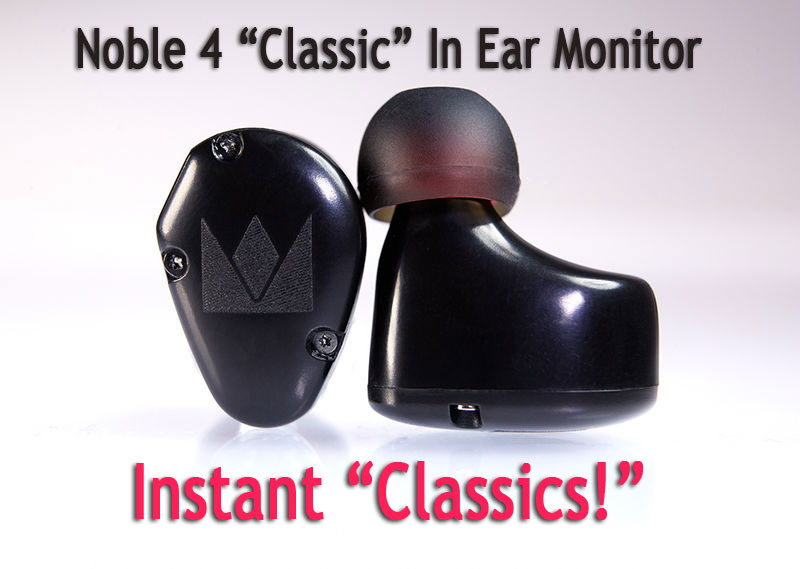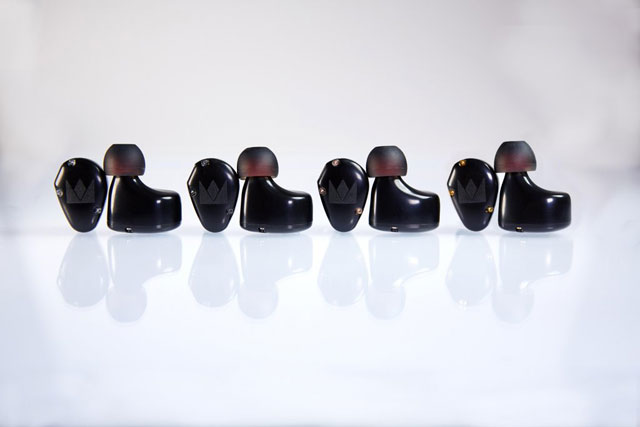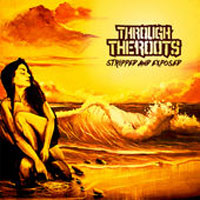Noble 4 In-Ear Monitor headphones

 While professional musicians look to Ultimate Ears, Westone and Jerry Harvey Audio for in-ear monitors, no brand has catered exclusively to audiophiles. I believe Noble will fill this void and become the quintessential in-ear monitor brand for audiophiles. Noble Audio is a small company whose owners are Dr. John Moulton, an audiologist who has developed in-ear monitors for almost 10 years, and Brannan Mason, who runs operations, sales, and marketing.
While professional musicians look to Ultimate Ears, Westone and Jerry Harvey Audio for in-ear monitors, no brand has catered exclusively to audiophiles. I believe Noble will fill this void and become the quintessential in-ear monitor brand for audiophiles. Noble Audio is a small company whose owners are Dr. John Moulton, an audiologist who has developed in-ear monitors for almost 10 years, and Brannan Mason, who runs operations, sales, and marketing.
The Noble 4 “Classic” In Ear Monitor headphones which were available for most of 2015 were recently discontinued. They are currently sold out on Moon Audio (https://www.moon-audio.com/noble-audio-noble-4-universal-iem.html) but watch for them on eBay. I believe this to be a disappointing development considering these were, in my opinion, among some of the most revealing pieces of equipment available on the market in this price range. Within the Universal Monitor Series, the 4-driver Noble 4 ($450) provides the greatest bang for your buck of anything that Noble has produced.

Noble’s current offerings that are comparable offer either less value (3-driver Trident, $399, https://nobleaudio.com/en/shop/universal/) or, the more expensive without any real noticeable improvements in specifications (the 4-driver Savanna, $499), (the 2-driver Savant $599). If you want a more expansive sound and are willing to shell out for it, there’s also the 5-driver Dulce Bass ($699), 6-driver Django ($999), Kaiser 10U 10-driver ($1650), or the 9-driver Katana ($1850).
In unboxing the N4s the first thing I noticed was a sleek, yet simple packaging. I opened the shipping box to find a Noble logo box with an impressively secure hard case. The contents of the case was reminiscent of a clown car, I wasn’t sure I could possibly fit everything back into the box once I had removed all the accessories they had included along with the headphones themselves. I removed an IEM cleaning brush, two logo bands, 4 different sized sets of ear piece tips, a warrantee manual, a “Please Return Here!” card (which you may write your name and contact information on and pray to all that is good and holy in the world that a Mother Teresa-like type happens to find your pricey equipment in the event you lose it) and finally, the headphones themselves. The packaging for the most part is simplistic and basic. This isn’t a bad thing, almost symbolic of the equipment itself, not pretentious or trying to be something it’s not.
The N4s are comfortable though a tad bulky in my opinion. I find that the issue for me is that at times I enjoy lying down while wearing IEM’s before bed and this particular headphone makes this a bit uncomfortable. I was pleased however with the silicone shell of the acrylic pieces, as they definitely maintain a tight seal and avoid leaking of sound. Overall, lightweight on the ear and the black finish makes it aesthetically appealing alongside whatever equipment you’re listening on.
 I first sampled Coldplay’s “A Head Full Of Dreams”, the album’s title track, which has fairly unmistakable U2 vibes including a pulsing bass riff underneath and only one core melody. I was hoping to hear a greater distinction in the bass in the N4s here. I was pleasantly surprised to hear a more profound and robust resonance in the steady and rhythmic percussive instruments, yet still not as much as I desired in the bass foundation. I moved onto the album’s second track, “Birds,” which opens exclusively with a drum and timpani beat. Still not enthused by the lack of the crisp sharpness I’d expect in my ears from what I believe should be featured here. My issues with the bass aside, I still remain impressed with how I am able to hear the nuances in front-man Martins’ vocal stylings so effortlessly. I feel he has tendency to fluctuate between easily understood and almost overly expressive at times, meaning his words get lost to my ears occasionally due to his vocal styling. I didn’t have any issues understanding him at any point using the N4s which was a welcome perk of this equipment. The Classic’s may be the ‘bread and butter’ of this type of equipment, but a track like this was precisely what was called for; their ability to not allow one particular area of orchestration or vocals overpower another was just what the recipe called for in my opinion.
I first sampled Coldplay’s “A Head Full Of Dreams”, the album’s title track, which has fairly unmistakable U2 vibes including a pulsing bass riff underneath and only one core melody. I was hoping to hear a greater distinction in the bass in the N4s here. I was pleasantly surprised to hear a more profound and robust resonance in the steady and rhythmic percussive instruments, yet still not as much as I desired in the bass foundation. I moved onto the album’s second track, “Birds,” which opens exclusively with a drum and timpani beat. Still not enthused by the lack of the crisp sharpness I’d expect in my ears from what I believe should be featured here. My issues with the bass aside, I still remain impressed with how I am able to hear the nuances in front-man Martins’ vocal stylings so effortlessly. I feel he has tendency to fluctuate between easily understood and almost overly expressive at times, meaning his words get lost to my ears occasionally due to his vocal styling. I didn’t have any issues understanding him at any point using the N4s which was a welcome perk of this equipment. The Classic’s may be the ‘bread and butter’ of this type of equipment, but a track like this was precisely what was called for; their ability to not allow one particular area of orchestration or vocals overpower another was just what the recipe called for in my opinion.
 Amy Winehouse’s smash hit Back to Black is a go to album for me: a pop album from the past ten years that I thoroughly enjoy. Winehouse is far more gritty lyrically than any of her peers in my opinion (for instance, Adele or Lady Gaga could never dream up most of the material she threw on the table, especially Rehab, or You Know I’m No Good), yet she managed to be accessible. I’m always interested in hearing how her smoky and unmistakably unique tone differ on each piece of equipment I hear her on. The N4s provided a surprisingly focused piercing sound in the treble peaks of her highs in songs such as Tears Dry on their Own, yet in more somber tunes such as Back to Black the bass and unhurried tempo of the smooth rhythm were almost completely muddled by the flatness of the sounds being almost TOO equal.
Amy Winehouse’s smash hit Back to Black is a go to album for me: a pop album from the past ten years that I thoroughly enjoy. Winehouse is far more gritty lyrically than any of her peers in my opinion (for instance, Adele or Lady Gaga could never dream up most of the material she threw on the table, especially Rehab, or You Know I’m No Good), yet she managed to be accessible. I’m always interested in hearing how her smoky and unmistakably unique tone differ on each piece of equipment I hear her on. The N4s provided a surprisingly focused piercing sound in the treble peaks of her highs in songs such as Tears Dry on their Own, yet in more somber tunes such as Back to Black the bass and unhurried tempo of the smooth rhythm were almost completely muddled by the flatness of the sounds being almost TOO equal.
Though I am a huge techie and enjoy a vast assortment of musical genres, I often take into consideration some of my girlfriend’s opinions when reviewing audio equipment. As a classically trained opera singer, she has a few unique points of insight to add in that I generally hadn’t considered or heard in my listening experience. She chose to use the N4s to listen to her favorite recording of Robert Shaw conducting the Atlanta Symphony Orchestra and Chorus performing ‘Ein Deutsches Requiem’ (A German Requiem). To my surprise, she was thoroughly impressed with the overall experience and evenness of the orchestral tone quality she heard throughout Brahms’ thematic introductions heard in the opening of the masterwork. She explained to me that in orchestral works, it is crucial to hear these themes initially. History’s greatest composers to the likes of Brahms, Strauss, Beethoven, Liszt, and Mahler are often recognized and categorized by their thematic nuances which are carried out throughout their works. She noted the exact opposite of the issue that I mentioned earlier in regards to a lack of bass focused sound, in the N4s and that she was pleased and it was refreshing that an in-ear monitor didn’t force her ear drums full of bass thumping percussive beats. She stated rather it allowed the orchestra’s sound to do its job in remaining level with what Shaw was commanding the instrumentalists to do which was staying in relation to one another, and that it was closely reminiscent of being present in a real live performance.
Hearing my girlfriend’s notes on the variations between the sound produced in classical music as compared to more modern music, I’d say Nobles product could be a great piece of equipment for anyone from a student studying composition or theory to a composing artist to consider as well. If utilized for educational or writing purposes they could absolutely make identifying instrumentation and harmonies easily recognizable from one another and in conjunction from themes as a whole. They’d be a great value to the analytical and interpretive aspects of composing and identifying musical ideas for music makers, not solely enjoyment for music enthusiasts.
 After sampling a broad range of musical styles using the N4s, it was clear to me that easy-listening genres were where this particular piece of equipment really served their purpose. One of the select groups that stands ahead of the crowd for me in terms of that easy- listening vibe is San Diego based, high-energy band, Through The Roots. Their 2015 EP titled “Stripped & Exposed” highlights uplifting music including a tantalizing blend of reggae, rock, and pop mixed with an incredible display of ear pleasing guitar, drums and keyboard/synth play to mesh seamlessly with the group’s catchy vocals and soulful swing. The N4s ability to not overpower front-man Evan Hawkins’ mellow and luscious vocals by the rhythmic momentum of the percussive swing bass is impressive to say the least. There is a clarity and an evenness of the treble timbre of synthesized sounds in tracks such as “Paradise” and “Dancing In The Rain”, which give credit to the power in Nobles use of multiple drivers found in the mechanical build of this particular headset. I gave major bonus points to the headset after hearing their powerful performance on this particular variety of music, which has such unique nuance of sound, I’d highly recommend anyone with any interest in easy-listening of any variety give these a try.
After sampling a broad range of musical styles using the N4s, it was clear to me that easy-listening genres were where this particular piece of equipment really served their purpose. One of the select groups that stands ahead of the crowd for me in terms of that easy- listening vibe is San Diego based, high-energy band, Through The Roots. Their 2015 EP titled “Stripped & Exposed” highlights uplifting music including a tantalizing blend of reggae, rock, and pop mixed with an incredible display of ear pleasing guitar, drums and keyboard/synth play to mesh seamlessly with the group’s catchy vocals and soulful swing. The N4s ability to not overpower front-man Evan Hawkins’ mellow and luscious vocals by the rhythmic momentum of the percussive swing bass is impressive to say the least. There is a clarity and an evenness of the treble timbre of synthesized sounds in tracks such as “Paradise” and “Dancing In The Rain”, which give credit to the power in Nobles use of multiple drivers found in the mechanical build of this particular headset. I gave major bonus points to the headset after hearing their powerful performance on this particular variety of music, which has such unique nuance of sound, I’d highly recommend anyone with any interest in easy-listening of any variety give these a try.
Overall with a $450 MSRP, the Noble Audio 4 “Classic” in-ear headphones is among the best value of anything that the company has produced when compared to the current line-up.
If you’re looking for a high quality in-ear monitor with a dynamic life, extended treble sound, and extraordinary detail, look no further. The N4s ability to cater to a diverse array of musical genres while simultaneously blending evenness of timbres and instrumentation is unmatched by many of its competitors. I highly recommend this piece of equipment to anyone looking to add a well-rounded IEM to their collection. 

mark abell
Specifications:
Noble 4
Price: $450.00 USA
4 balanced-armature drivers
2 precision tuned low frequency drive
1 precision tuned mid frequency driver
1 precision tuned high frequency driver
3-Way design
Impedance < 30
Detachable cable w/ industry standard two pin configuration
Slate pentalobe screws
Website: https://www.moon-audio.com/noble-audio-noble-4-universal-iem.html
Stereo Times Masthead
Publisher/Founder
Clement Perry
Editor
Dave Thomas
Senior Editors
Frank Alles, Mike Girardi, Russell Lichter, Terry London, Moreno Mitchell, Paul Szabady, Bill Wells, Mike Wright, and Stephen Yan,
Current Contributors
David Abramson, Tim Barrall, Dave Allison, Ron Cook, Lewis Dardick, John Hoffman, Dan Secula, Don Shaulis, Greg Simmons, Eric Teh, Greg Voth, Richard Willie, Ed Van Winkle, Rob Dockery, Richard Doran, and Daveed Turek
Site Management Clement Perry
Ad Designer: Martin Perry






Be the first to comment on: Noble 4 In-Ear Monitor headphones